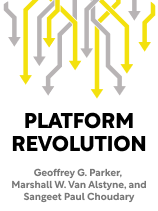

This article is an excerpt from the Shortform book guide to "Platform Revolution" by Geoffrey G. Parker, Marshall W. Van Alstyne, and Sangeet Paul Choudary. Shortform has the world's best summaries and analyses of books you should be reading.
Like this article? Sign up for a free trial here.
How do you build a platform business? What type of participants are important for platforms?
Platform business models are game-changers, and you might be inspired to start your own platform business. Geoffrey G. Parker, Marshall W. Van Alstyne, and Sangeet Paul Choudary cover three design fundamentals to consider as you get started.
Below we’ll look at how to build a platform business using the three design fundamentals.
1. Find Your Platform’s Purpose
If you want to know how to build a platform business, the authors recommend you start by defining its central purpose: the connection that users come to the platform for. Every connection can be broken down into three steps: First, the platform applies a software tool to create appropriate connections between producer and consumer (for example, a search tool that ensures someone looking for a dog sitter isn’t connected with a cat sitter.) Once the connection is made, the consumer can see what the producer has to offer. Finally, based on that information, the producer and consumer can choose whether to proceed further with a transaction. Usually, but not always, the transaction involves the consumer paying money for the producer’s offerings.
Parker, Van Alstyne, and Choudary stress the importance of highlighting your platform’s central purpose and sidelining additional features when you design your platform’s software. They explain that as your platform grows, users’ needs may evolve, and your platform should develop additional features to meet those needs. However, you should use software tools to make your central purpose visually dominant and easy to find (for example, by putting it on users’ homepages) while making additional features accessible through a navigation menu. This ensures that your central purpose doesn’t get lost or overshadowed and clarifies the value your platform offers to users.
To illustrate, consider the design of X. When you open the app, you see tweets from people you follow and recommended tweets—this makes sense since the platform’s central purpose is to connect users via tweets. If you want to take advantage of other features, like X spaces, you can navigate to them using the menu. This design allows users to access additional features without adding distracting clutter to the main feed.
2. Choose Your Participants
As you design your platform, you must make choices about which participants you want to invite to your platform and what they’ll be allowed to do. Parker, Van Alstyne, and Choudary primarily focus on two types of participants: users and external developers.
Attracting Users to Your Platform
Parker, Van Alstyne, and Choudary stress that to attract users to your platform, you must ensure your platform has obvious inherent value. One way to accomplish this is by ensuring that users can use your platform to make valuable connections in a straightforward, pleasant way—if it’s a hassle, users will lose interest. The authors list three strategies to attract users: First, promote easy access to your platform (for example, don’t charge a fee or require an ID for users to join) to increase your user base. Second, balance easy access with selectivity—don’t let low-quality users enter or remain on your platform. Third, utilize user data, like reports of abuse and activity patterns, to inform your decisions about selectivity and recommend high-quality connections.
New platforms also face a unique challenge—determining how to attract producers when there are no consumers yet, or vice versa, since the platform is only valuable if both types of users are active. The authors discuss several strategies you can use to address this challenge encouraging you to mix and match strategies to find the best approach for your platform:
Strategy #1: Piggyback on a pipeline. If you build a platform that has obvious value because it’s comparable to pipeline businesses in the same market, it’ll be easier to convince users to sign up. For example, Uber has obvious value as an alternative to traditional taxi companies.
Strategy #2: Generate buzz with a small initial network. If you capture a very small percentage of potential users and gain publicity by proving your value, it’ll be easier to scale up later. For example, Pinterest used an invite-only model to create exclusivity and generate early interest before widening access.
Strategy #3: Recruit key consumers or producers, but not both. If you retain a subset of clearly valuable users, users of the other type will soon flock to your platform. For example, the celebrity video message platform Cameo started off with minor-league celebrities to draw in the fans who wanted to hear from them.
Strategy #4: Choreograph an exemplary product launch. If you accumulate exemplary offerings from key producers, consumers will be more inclined to engage with your platform from the beginning, fostering trust and loyalty. For example, Spotify started out with a limited library of streamable music to attract consumers and then expanded its library as it grew.
Orchestrating External Developer Relationships
In addition to attracting users, you must carefully orchestrate your platform’s relationships with external developers, the software engineers and data aggregators that develop extensions, applications, and advertising strategies to help users get the most value from your platform. Parker, Van Alstyne, and Choudary stress that third-party developers can siphon money from your platform if their creations are productive, so it’s important to acquire companies or creations that add significant value to your platform. For example, that’s why Twitter acquired TweetDeck, a third-party application that helped users customize their experience. It’s also important to manage data acquisition and sharing ethically to maintain user trust.
You should have a plan for orchestrating these relationships in mind as you design your platform, but the authors recommend keeping an open mind: As the market transforms over time, it may behoove you to allow external parties more or fewer permissions to work with your platform.
3 Decide How to Turn a Profit
The authors explain that profiting from your platform can be difficult because most of the obvious profit-making strategies, like charging users to join, can lower your platform’s value by impeding easy access and decreasing the size of your network. For this reason, many platform designers elect a free or “freemium” (free with paid premium upgrades) model until the network is sufficiently built up. Then, they can consider implementing profit-making strategies. If you have a similar plan for your platform, note that charging for benefits that were once free—like access to basic features—is a surefire way to make users feel exploited, which could lead to an exodus of users. Instead, create additional value (like exclusive content or an ad-free experience) and charge for that.
Effective profit-making strategies capitalize on user benefits—like producers’ and consumers’ access to each other—without motivating users to leave the platform or use it less frequently. This requires understanding the spending ability of each user market—for example, ultra-profitable producers may have more money to work with than consumers with little disposable income.
Effective profit-making strategies include:
- Upgrading selectivity services for a fee. For example, you might offer tiered subscriptions that give users access to higher-quality offerings.
- Billing users for access to each other. For example, you might let producers pay to find out more about consumers’ desires so they can tailor their offerings.
- Taking a percentage of payouts. For example, you might impose a service fee on consumers or take a share of producers’ profits for each transaction.

———End of Preview———
Like what you just read? Read the rest of the world's best book summary and analysis of Geoffrey G. Parker, Marshall W. Van Alstyne, and Sangeet Paul Choudary's "Platform Revolution" at Shortform.
Here's what you'll find in our full Platform Revolution summary:
- How platforms like Spotify and Amazon became so successful
- What makes platform businesses so unique and competitive
- Tips for aspiring platform entrepreneurs






